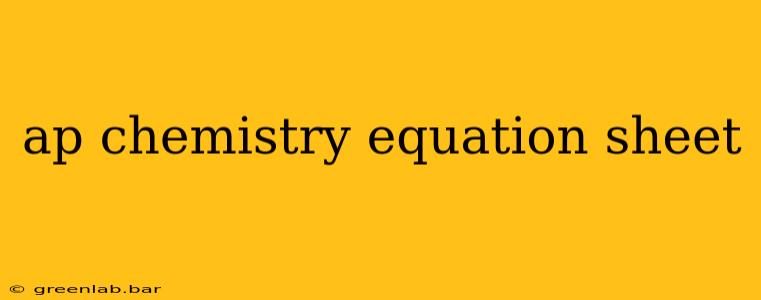The AP Chemistry exam is notoriously challenging, and having a solid grasp of the fundamental equations is crucial for success. This comprehensive guide goes beyond a simple equation list; we'll explore the context, application, and nuances of each key equation, empowering you to confidently tackle any problem thrown your way.
Essential Equations and Concepts
This section breaks down the core equations you'll encounter in AP Chemistry, categorized for easier understanding. Remember, rote memorization isn't enough; understanding the underlying principles is key.
1. Stoichiometry and Mole Relationships
-
Moles = mass (g) / molar mass (g/mol): This is the cornerstone of stoichiometry. It allows you to convert between grams and moles, essential for calculating reactant amounts, limiting reagents, and theoretical yields. Remember to always use the correct molar mass for each substance involved.
-
Percent Yield = (actual yield / theoretical yield) x 100%: This equation helps assess the efficiency of a chemical reaction. Understanding the difference between actual and theoretical yields is vital for interpreting experimental results. Factors like incomplete reactions and side reactions can affect percent yield.
-
Molarity (M) = moles of solute / liters of solution: This is crucial for solution stoichiometry. Understanding molarity allows you to calculate the concentration of solutions and perform dilutions accurately.
2. Gas Laws
-
Ideal Gas Law: PV = nRT: This is perhaps the most important equation in gas chemistry. It relates pressure (P), volume (V), number of moles (n), temperature (T), and the ideal gas constant (R). Understanding the conditions under which the ideal gas law applies and its limitations is vital.
-
Combined Gas Law: (P1V1)/T1 = (P2V2)/T2: This equation combines Boyle's Law, Charles's Law, and Gay-Lussac's Law into one useful tool for solving problems involving changing gas conditions. Remember that temperature must be in Kelvin.
3. Thermodynamics
-
ΔG = ΔH - TΔS: This Gibbs Free Energy equation is central to understanding spontaneity of reactions. It relates Gibbs Free Energy (ΔG), enthalpy (ΔH), temperature (T), and entropy (ΔS). A negative ΔG indicates a spontaneous reaction.
-
ΔH = q (at constant pressure): This equation links enthalpy change (ΔH) with heat (q) at constant pressure. Understanding the sign convention for ΔH (positive for endothermic, negative for exothermic) is essential.
4. Equilibrium
-
Kc = [products]coefficients / [reactants]coefficients: This equilibrium constant expression is crucial for calculating the equilibrium constant (Kc) for reactions in solution. Understanding how changes in conditions affect the equilibrium position (Le Chatelier's Principle) is also vital.
-
Kp = (Pproducts)coefficients / (Preactants)coefficients: This equilibrium constant expression is used for reactions involving gases, where partial pressures are used instead of concentrations.
5. Acids and Bases
-
pH = -log[H+]: This equation defines pH and allows you to calculate the pH of a solution given the hydrogen ion concentration. Remember that pH and pOH are related by pH + pOH = 14 at 25°C.
-
Ka = [H+][A-] / [HA]: This acid dissociation constant expression is used to calculate the Ka value for weak acids.
-
Kb = [OH-][HB+] / [B]: This base dissociation constant expression is used to calculate the Kb value for weak bases.
Beyond the Equations: Mastering AP Chemistry
While understanding these equations is critical, success in AP Chemistry requires a much broader skillset. You must also master:
- Unit Conversions: Be comfortable converting between various units (grams, moles, liters, etc.).
- Dimensional Analysis: This is a powerful tool for solving complex problems systematically.
- Understanding Chemical Concepts: Don't just memorize equations; understand the underlying chemistry principles.
- Problem-Solving Strategies: Develop a systematic approach to tackling complex problems.
By combining a solid understanding of these equations with strong problem-solving skills and a thorough grasp of fundamental concepts, you'll be well-prepared to conquer the AP Chemistry exam. Good luck!

